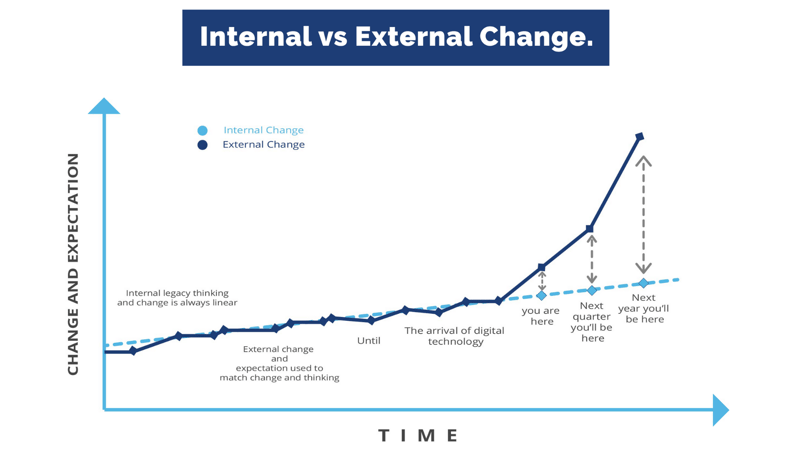
As we see some light at the end of what has been a significantly difficult tunnel to pass through for most organisations, it is critical that we carry the momentum of that rapid pivot into remote and digital collaboration ahead through whatever the future brings.
I’ve written before about the incredible response to the first wave of the pandemic and what we learned about digital transformation as a result. As a nation, businesses and organisations of every size and every sector achieved what could take cautious business months or years, in a single long weekend.
This response was amazing to witness. It showed us that we can move rapidly to adapt to external change. That we may not have had all the answers or even knew the final destination but still implemented bold, digital change quickly and without the need for perfection and months of planning.
We did this because the external landscape changed, and this change threatened our business’ very existence. All company executives must view this as a microcosm of the digital age. It is no different, the stakes are the same. Either continue to adapt to external digital change or become irrelevant. New digital entrants to your market and competitors who have adopted new ways of working are outward-facing in their orientation and who exist with a permanent mindset of innovation are going to swallow your customers. And they’re going to do it quickly. They after all are the companies who can meet or exceed their customer’s digital expectations.
Being digitally mature now has a name. Both digitally mature organisations and those that are digitally native are referred to as “Digital Masters”. Sounds impressive? It is. It’s also pretty rare and this moniker isn't used lightly but it’s what we should all be striving for. There are two key elements to becoming a Digital Master. Firstly, digital capability. This is the ability to use and implement new technology to deliver compelling customer experiences and improve the operational elements of the business. The second is Leadership Capability. This capability enables digital masters to drive organisational change in systemic and profitable ways.

So how can we emerge from the pandemic with digital momentum and start to work towards becoming a Digital Master?
Your first priority is to create a Vision for transformation. This can be quick and simple to craft and is the best way to get some buy-in and budget from senior leadership. It’s likely that as your company has evolved that it may not be delivering against its mission statement or core purpose for existing. The older your business, the more likely this is. It’s critical to get into the “founders' mindset” for this exercise. When your company was founded it was almost certainly perfectly positioned to meet the wants and needs of its target audience. But time has passed and it’s a safe bet that the world and your customers have changed faster than your business. If you’re a financial services organisation in the business of making loans to businesses and you market your service as “Quick and Easy” but still require customers to complete paper forms or scan documentation then in a nutshell, it’s neither quick nor easy. You aren’t delivering against your promises to your customers. That’s because you aren’t digitally transformed, there are much quicker and easier experiences your target customers can get elsewhere, and you are at genuine risk of losing your customers to competitors who can provide the services that you should be providing.
Vision for transformation.
Use this mindset to craft a vision for transformation. If you were setting your organisation up today. What would you strive for? What would your core purpose be and how would you deliver that purpose to your target market?
The vision can consist of 5 to 10 goals or statements which will underpin your transformation. This is and should be a living construct. After all the idea of being a digital organisation is to keep pace with external digital change.

For example: “Acme Business Loans Ltd will deliver funding to business customers in less than 5 minutes, becoming the quickest and easiest end to end service in the UK”
This statement is clear. If it was your only statement, then it would still be a pretty powerful vision on its own. And every digital initiative you undertake from here should further that core purpose. However, a statement like this on its own isn’t enough. We also need to know why we need to do this. So do some analysis. Not belt and braces but enough to quantify why this particular objective is critical and how you are currently positioned against it. At this point, solutioning and planning are not relevant. Think ambitiously and with the founder's mindset. So:
Acme Business Loans Ltd will deliver funding to business customers in less than 5 minutes, becoming the quickest and easiest end to end service in the UK.
- Our current end-to-end service is 3 days, this is not a compelling proposition for costumers in the digital age. Our competitors offer 1-day services.
- Our current service is complex and includes manual document signing which often frustrates customers and causes non-completion. We currently lose 18% of all customers at this stage.
- A frictionless, 5-minute end-to-end service would enable Acme Loans to win business from competitors and reverse the current downwards trend. This service would also increase retention rates. Current retention and repeat business is low.
Get input and collaborate with senior leadership and service owners. They have the knowledge. They are closer to the voice of the customer. Share it around, but don’t make it a huge piece of work in itself. If at a later stage it requires a new objective because the external landscape has changed then update as required. It is a living, breathing artefact. Make it public (internally) and start to live by it. Now you have a Shared Vision for Transformation.
Gaps.
Secondly, it is critical to assess where you are now, and where you need to get to. Where are the gaps and how big are they? When we talk about gaps, we must look at both external gaps and internal gaps. So, the gaps between your services and your customers' expectations. The gaps between what you promise to deliver and what you actually deliver. Look at your vision. If your organisation has been operating for more than a decade and you haven’t digitally transformed, it’s extremely likely that you no longer deliver what you once did in terms of a customer experience. You haven’t kept up with the pace of external digital change. So, there’s a gap. There are also gaps between your existing technology and the external technology landscape. What do your competitors offer that you don’t’, can’t? What are the experiences and services that your customers value? Either within your specific area of product and service or outside of that?
Internal gaps are no less important to mitigate. In a large hierarchical organisation, there are gaps between business units and organisational silos. There are gaps between leadership and teams on the ground. And the biggest gap of all is commonly the void between the voice and the wants of the customer and the executive leadership of your organisation. The bigger the company, the further away your leadership is from hearing your customers.
Understanding the gaps that need to be bridged is the first half of shaping a digital transformation. The second half is flushing out the barriers to transformation. I’ve written extensively about this aspect in the past and it remains the most critical aspect of transformation.
Barriers.
You will encounter barriers at every turn. They are everywhere and mitigating these barriers to achieve your vision for transformation is the very essence of digital transformation.
To flush out barriers, perform analysis across People, Processes, Platforms and Partners. There are well-tested techniques and approaches for each area of analysis. Essentially you are aiming to end up with a clear view of every issue that needs to be mitigated in each of these categories to achieve your vision.
These internal and external gaps combined with the barriers you have uncovered can be framed as individual digital initiatives or projects (I use that word with caution). But it needs buy-In, support and a mandate from the top. Digital Transformation isn’t an IT project, but I’ll come onto that later. Also putting all of these into a huge waterfall project plan to deliver over the next 2 years is precisely the wrong way to approach this. I’ll come onto that later too.
So, you have a view of where you are now and where you need to be and what the issues are that need to be mitigated. It’s time to transform. This can be hard or not. It all depends on how you approach change in your organisation. If you are struggling with highly regulated change, decision by committee and people treating digital like a box-ticking exercise then you will have hopefully explored and mitigated this when you uncovered the barriers.
How to gain digital momentum.
The best way to achieve some momentum is to start small. Critically, solutions must be developed iteratively. You don’t need to be a fully Agile organisation with every role and ceremony observed meticulously to deliver iterative change. There are however some fundamentals that you need to implement, drive and mandate to increase both value and the odds of lasting, successful change.
Digital change is business-led.
Firstly, successful digital change is business-led. Of course, any technology change will require the services of your technology department. But your IT team simply don’t know what you and your customers' needs are. So, it’s basic common sense that the business leads the change, leads the development, and is fully involved in daily stand-ups, testing and defining the scope and priorities of each sprint. A simple way to achieve this is assigning a product owner from the business who becomes the voice of the customer or user, prioritising features using the MoSCoW method and Kanban to manage the development. That’s more or less all you need.
Iterative product development.
Secondly, Products and solutions are released rapidly and improved with user feedback. Not when they are perfect. If a sprint has been led by the business and moves your organisation further towards your transformation objectives, then you achieve project value as early as possible. Furthermore, you minimise waste by not working on features that don’t produce any value or are no longer considered a priority.

Summary.
Following this simple approach will get your organisation on the way to being digital, streamlined futureproof and ultimately enable it to thrive in the digital age. Achieving some early success and showing the genuine benefits of new ways of working, business-led change and a mindset of innovation will garner support and ultimately budget, resource and support from your executive leadership.
Of course, digital transformation is a huge undertaking and there will be failures along the way. However, this approach ensures that you haven’t wasted months, years and a large budget working on solutions that are not fit for purpose or turn out to be wrong. Being wrong isn’t an issue, as long as you learn rapidly and emerge a more successful organisation.
I’ll write more in the coming weeks about some of the more challenging areas of transformation. In particular; digital culture. What it is, and how to achieve it.
But for now, let's take this time to ensure we all emerge from the COVID crisis with digital momentum. The world isn’t standing still and waiting for us to catch up.



